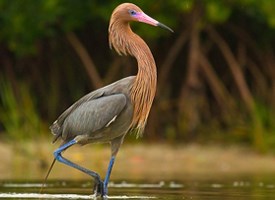When a specific species arrives, it might stay for several days, weeks or even months at a time. That’s been the pattern with a variety of herons, sandhill cranes, ospreys, eagles, belted kingfishers, pied-billed grebes and other avian species that frequent bodies of fresh water in Central Florida.
 |
| A pair of sandhill cranes have been seasonal regulars to our lakeside property |
Lately, I’ve spotted a new “regular” trolling the shallow water and reeds along the shoreline in search of prey. With its white plumage and fairly large size, this most recent visitor has been easy to notice. What hasn’t been so easy, at least for an inexperienced birder like me, is to confidently identify exactly what species of waterbird I’ve been watching.
 |
| The bird's white plumage stands out but IDing this new visit hasn't been as obvious |
My first thought was that I’d spied a great egret, a white-feathered, yellow-billed, three-foot tall beauty with long black legs and an almost five-foot wingspan. But I wasn’t sure. Although tall, the bird I kept seeing didn’t seem quite tall enough to be a great egret.
In addition to its slightly smaller stature, the bird I was watching didn’t have the right color bill or legs. Its bill was two-toned, neither completely black nor yellow and its stilt-like legs looked like they were greenish-yellow instead of black like a great egret.
 |
| Great egret in the sunlight |
From time spent at the beach, I knew it wasn’t a snowy egret, another white-plumed wading bird found in our region of the state. Not only do snowy egrets have distinctively colored legs, feet and bills — black legs, black bills and bright yellow feet — they also gravitate more toward saltwater locations than freshwater habitats. I regularly see snowy egrets by the ocean and lagoons in New Smyrna Beach but, I’ve never seen one hunting in our lake during the 25 years we’ve lived in Groveland.
 |
| Snowy egrets are a common sight at the beach where they often hang out by fishermen in hope of gaining an easy meal |
Another white feathered bird I confidently eliminated was the cattle egret. Much smaller than the bird I was watching, a cattle egret is a terrestrial feeder inhabiting newly-mown fields, pastureland, roadsides and dry upland areas. In addition to not being a wading bird, cattle egrets also tend to travel in flocks, and this white-feathered visitor to our lake was traveling solo.
 |
| Cattle egrets are small white, land birds that congregate in pastureland, lawns and fields |
Because of its two-toned bill and light-colored legs, I disregarded the possibility that the lake’s newest resident was a reddish egret, which, like the snowy egret, has dark black legs and a matching bill. Although its name suggests otherwise, an immature reddish egret goes through a white-plumage stage. However, reddish egrets are primarily saltwater birds, not commonly found on small inland lakes.
 |
| Mature reddish egret |
So what kind of bird have I been seeing? Feeling stumped, I sought out answers in reference books and online sites. My research led me to the surprising conclusion that the medium-sized white bird I’ve been observing is an immature little blue heron.
 |
| My latest avian visitor might well be an immature little blue heron |
At slightly under three-feet tall with a 41-inch wingspan, an adult little blue heron has bluish-gray plumage with a red or purple toned head. However, during the first year of its life, immature birds go through a period when their feathers are completely white. Both adults and juvenile birds have greenish-yellow legs and two-toned bills. And, while they can be found frequenting saltwater locations, they are commonly seen in freshwater as well.
 |
| Mature little blue heron |
When it comes to matters of plants and animals, I like to think of myself as an aware person. I try to pay attention to my surroundings and learn as much as I can about my wildlife companions. But, as much as I’ve learned over the years, I’m wise enough to know how much more there is to discover.
Birds may come, and birds may go from our little tucked away nature preserve, but the one aspect of country life that never changes is my fascination for all things wild, free and independent.

No comments:
Post a Comment